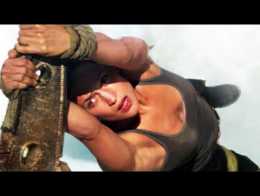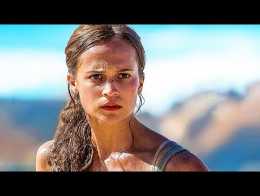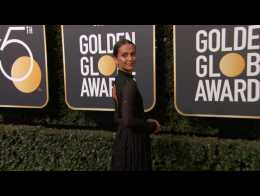Review of Tomb Rider Movie
Call it the curse of Super Mario Bros: in 1993, Nintendo’s hit franchise was the subject of the first ever game-to-movie adaptation, and the results were infamously strange. Ever since, the whole sub-genre’s struggled to gain an even footing; for every half-decent videogame spin-off like Christophe Gans’ Silent Hill we’ve had what feels like several dozen low-rent abominations like Alone In The Dark or Postal.
Even more recent efforts, like Ubisoft’s in-house movie Assassin’s Creed,have struggled to rise far above the mediocre - all this, despite some decent talent behind the camera (director Justin Kurzel) and in front (Michael Fassbender). It’s only fitting, maybe, that it falls to Lara Croft to try to lift the Curse of Super Mario Bros, given that she’s a character who’s encountered a curse or two in her various adventures.
Not that this is the first incarnation of the heroine to grace the silver screen; Angelina Jolie wore the short-shorts and tight vest first in 2001’sLara Croft and its sequel, Lara Croft: The Cradle Of Life, two films that did okay, but didn’t exactly do much to rehabilitate the videogame movie’s shonky reputation. The difference with Tomb Raider, though, is that Oscar-winning actress Alicia Vikander (Ex Machina, The Danish Girl) isn’t being asked to take on the oddly-proportioned 90s version of Croft, but the more recent one from the 2013 videogame reboot, who’s more vulnerable to injury and less quick to wield a pair of semi-automatic pistols.
Tomb Raider’s directed by Norway’s Roar Urthaug, who came to wider attention thanks to his unusual 2015 disaster flick, The Wave - unusual, because Norwegian cinema isn’t typically associated with effects-heavy, Roland Emmerich-style movies. But Urthaug brought some visual flair and energy to a fairly stock survival tale, and he does pretty much the same thing here: there isn’t an original bone in Tomb Raider’s body, but that doesn’t mean it doesn’t entertain while the action’s going.
Before all the tomb raiding starts, though, the adventure begins in London, with an opening that looks like The Fast And The Furious on mountain bikes. Lara Croft’s descended from landed gentry, as she was in the games, but her archaeologist’s father, Lord Richard Croft (Dominic West) vanished seven years earlier, and Lara’s turned her back on her upper-crust ancestry. Instead, she’s a member of the gig economy, earning a small wage delivering meals on a pushbike, hanging around at a local MMA gym, and generally wondering how she’ll pay her rent. But then a vital bit of information comes to light about Richard Croft’s whereabouts, which leads Lara on a journey to China and then a mysterious island in the middle of a dangerously rough sea.
Along the way, Lara meets a cool sidekick, Lu Ren (Daniel Wu), a Hong Kong sailor whose father also vanished on the same island, and the villain of the piece, Mathias Vogel (Walton Goggins, good value as always), who wants to find the island’s hidden tomb on behalf of an obscure organisation called Trinity.
Written by Geneva Robertson-Dworet and Alastair Siddons, Tomb Raider is a veritable compendium of pulp, both cinematic and literary. The island, surrounded by the husks of dead ships and planes, is straight out of theKing Kong movies; the debt to the likes of Allan Quartermain, Indiana Jones and even The Goonies is fairly obvious, given that the games pilfered so much from them at the same time. But Tomb Raider’s almost fetishistic tendency to make Croft suffer - she’s beaten, speared, grazed, throttled and so forth - vaguely recalls Sly Stallone’s Rambo series. It’s difficult to think of another film where the heroine’s grunted, screamed and gasped quite so much as here; even The Hunger Games’ Katniss Everdeen (another likely inspiration for some of the scenes here, what with all the archery) wasn’t put through the wringer to quite this extent.
Vikander handles all this gamely, and while she makes a somewhat unlikely heroine, with her slight frame and tendency to run full-pelt from a fight rather than attack it head-on, this still fits with the new games’ less indestructible heroine. For his part, Urthaug gives Tomb Raider’s action and survival sequences a pleasing bit of vim and grit - you can spot the green screen in the more outlandish moments, but he keeps things rattling along to such a degree that it barely notices. The same elemental roar of water that electrified The Wave also helps quicken the pulse here.
If there’s one thing that consistently lets Tomb Raider down, it’s the parched dialogue, which entirely lacks the laconic humour and youthful enthusiasm of a adventure classic like Raiders Of The Lost Ark. Vikander’s great, but the dialogue’s serviceable rather than filled with zingers; as catch phrases go, “At least we’re not dead” isn’t exactly James Bond. Similarly, Walton Goggins almost threatens to be a really good villain at one point: he’s wild-eyed and weird, as you’d expect from Goggins, so it’s a pity that there isn’t more for him to get his teeth into.
It’s telling, really, that for all the advances in lighter cameras and digital visual effects, we’ve yet to see another film of this ilk top Indiana Jones’ first outing. Still, this obviously isn’t a criticism that can be solely directed at Tomb Raider, and given the less-than-illustrious line of videogame adaptations that have come before it, this one’s far better than most. Predictably, there are hints everywhere that Lara Croft will be back for a sequel if this one does the required business; it’s to Tomb Raider’s credit that a second film doesn’t feel like such a bad proposition.






